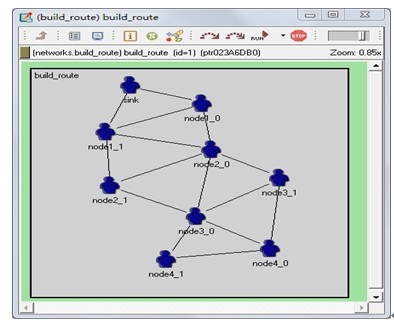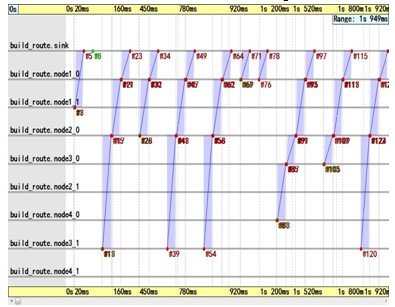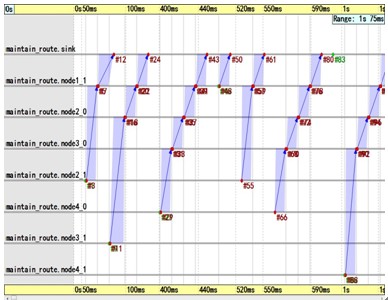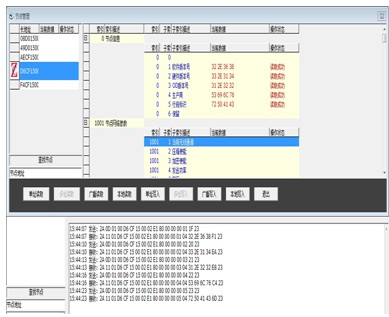At present, China's automatic meter reading technology mainly include the IC card , electric power carrier meter reading and RS485 bus meter reading, but these techniques each have a lot of disadvantages. IC card meter can't realize online real-time monitoring because table with direct contact with the user is easy to damage. Power carrier meter reading is susceptible to electromagnetic interference,seriously affecting the quality of communication. For RS485 bus meter reading technology, the data transmission reliability is higher, but the wiring is difficult and later maintenance is complex. Therefore, wireless meter reading technology is easy to implement, high transmission rate, low cost and easy to popularize, will become the inevitable trend of the future development of Chinese public utilities.
Researchers from Shenyang Institute of Automation (SIA), Chinese Academy of Sciences developed a routing protocol for wireless meter reading system as Fig.1. Through the algorithm every node in the network establishes optimal routing and registers a complete neighbor table. The neighbor exchange mechanism based on Hello Packet can timely detect changes in network topology and solve the problem of nodes flexibly coming in or out of the network. Simulation and system testing have all verified the reliability and usefulness of the algorithm which can satisfy the need of wireless meter reading application.

Fig. 1 The structure of wireless meter reading network (Image privided by WANG Xin et.al)
The routing algorithm for wireless meter reading system is as follows: Each node in the network has a neighbor list. When receiving Route Request Packet relayed by different neighbor node, the node compare Node_length value with their own depth value iNode_length.Acoording to the compare results the node adds the information of upper hop node to the neighbor table, modifies the Relation value and broadcasts the Route Request Packet. After forwarding Route Request Packet, node access to its neighbor table to choose the optimal parent node and register it to the routing table, then package and send routing table information to the parent node. Low power consumption, external disturbance or man-made factors will make node offline. According to this, routing maintenance algorithm based on bidirectional Hello Packet is proposed to keep reliable routing to server.Nodes in the net periodically broadcast the Hello Packet to the neighbor node, When neighbor nodes receiving the Hello Packet, add its depth value of iNode_length into packet, then single-route broadcast to the source node. Once The source node receives the Hello Reply Packet, check and update its neighbor table.
The wireless network model is established through the network simulation software OMNeT++ to verify the reliability of the routing algorithm. Network topology is shown in Fig.2.

Fig. 2 The network topology diagram (Image privided by WANG Xin et.al)
As data transmission diagram shown in Fig.3, each node in the network maintains its optimal route to the central node, along the optimal route data was transferred to the center node. For example, the 3 _1node uploads its data to the sink via 2_0 and 1_0 node. Fig.4 is data transmission diagram after the 1_0 node become invalid, it can be seen that 2 _0 node choose the 1_1 node as a new parent node to update its routing table, ensure reliable route to the center node.
A wireless monitoring software is developed to test the wireless meter reading system, mainly includes networking testing, the node parameter configuration testing.


Fig. 3 The data transmission diagram. Fig. 4 The data transmission diagram after the 1_0 node become invalid (Images privided by WANG Xin et.al)


Fig. 5 The networking response of 40 nodes Fig. 6 The parameters configuration response (Images privided by WANG Xin et.al)
As shown in Fig. 5, monitoring software sends Route Request Packet to 40 nodes, terminal nodes complete routing registration and return routing information to server. Fig. 6 is the parameters configuration response picture. System testing further verifies the stability and reliability of the routing algorithm in wireless meter reading applications.
This work was presented on the 2013 International Conference on Sensors, Mechatronics and Automation (ICSMA 2013) held in December, 2013 in the city of Shenzhen, China. It is supported by National 863 Project of China (2011AA040102).
CONTACT:
Wang Xin
Shenyang Institute of Automation, Chinese Academy of Sciences
E-mail: wangxin@sia.cn